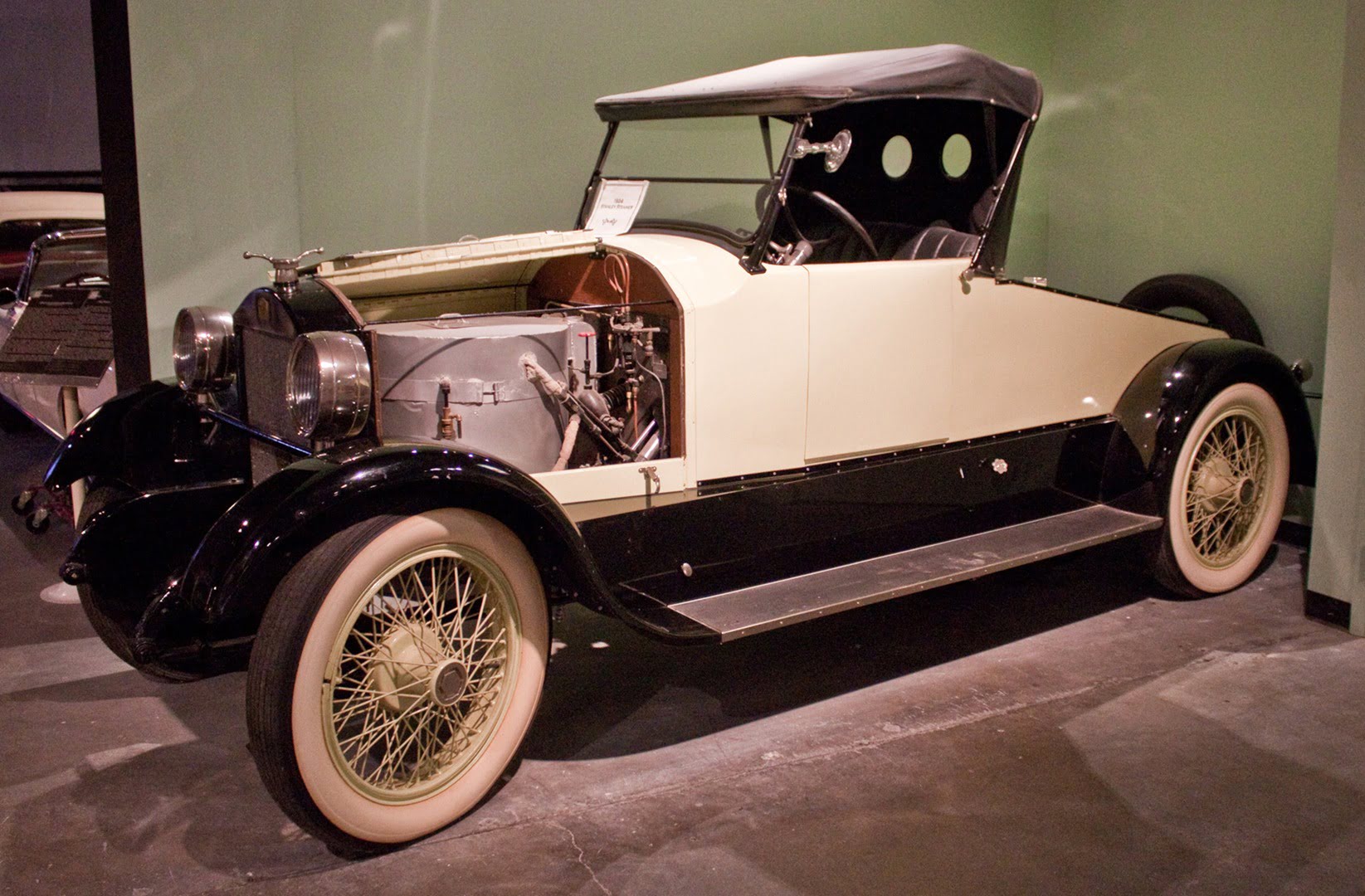

Articles
What Is A Stanley Steamer
Modified: January 6, 2024
Discover the history and technology behind the iconic Stanley Steamer with our informative articles. Learn about the revolutionary steam-powered vehicle that shaped the automotive industry.
(Many of the links in this article redirect to a specific reviewed product. Your purchase of these products through affiliate links helps to generate commission for Storables.com, at no extra cost. Learn more)
Introduction
The Stanley Steamer is a remarkable piece of automotive history that revolutionized early transportation. It was one of the first successful steam-powered vehicles and played a significant role in the development of automobiles in the late 19th and early 20th centuries. In this article, we will explore the fascinating history, working principles, advantages, and drawbacks of the Stanley Steamer.
Imagine a time before fuel-powered engines dominated the roads, when steam was the primary source of power for vehicles. That’s when the Stanley Steamer emerged, capturing the imagination of the public and pushing the boundaries of automotive engineering.
Developed by the Stanley brothers, Francis and Freelan, the Stanley Steamer introduced a unique method of propulsion that relied on the power of steam. It quickly gained popularity and became known for its efficiency, reliability, and elegant design.
This revolutionary vehicle was anything but ordinary. It featured a distinctive appearance, with a long, sleek body and spoked wheels, catching the eye of anyone who encountered it on the road. The simplicity of its design, coupled with its distinctive features, made the Stanley Steamer a true icon of its time.
Throughout its history, the Stanley Steamer proved itself to be a remarkable engineering feat. It was renowned for its smooth and quiet operation, providing a comfortable and enjoyable driving experience. Unlike internal combustion engines of the time, the Stanley Steamer relied on steam power to propel itself forward.
Stepping into a Stanley Steamer was like stepping into the future. The interior was often adorned with luxurious materials like leather and wood, creating a sense of elegance and sophistication. Passengers could enjoy a smooth ride while marveling at the advanced technology at work under the hood.
While the Stanley Steamer may have had its limitations, it undeniably left a lasting impact on the automotive industry. Its innovative use of steam power challenged the status quo and paved the way for further advancements in automobile technology.
Join us as we delve into the fascinating world of the Stanley Steamer and uncover the secrets behind its unique design, impressive performance, and enduring legacy.
Key Takeaways:
- The Stanley Steamer revolutionized early transportation with its steam-powered propulsion, offering smooth operation, immediate torque, and a symbol of elegance and luxury in the automotive world.
- Despite its eventual decline, the Stanley Steamer’s pioneering spirit and engineering excellence continue to inspire automotive enthusiasts and serve as a testament to the ingenuity of its creators.
Read also: 15 Amazing Stanley Power Strip for 2025
History of the Stanley Steamer
The Stanley Steamer has a rich and fascinating history that begins in the late 19th century. It was the brainchild of twin brothers Francis and Freelan Stanley, who were pioneers in the field of steam-powered transportation.
In 1897, the Stanley brothers introduced their first steam-powered vehicle, known as the “Stanley Steamer.” This initial model, called the Model A, was a horseless carriage with a steam engine housed in the rear. It had a sleek and elegant design, resembling a modern-day car, and quickly gained attention and popularity.
By 1902, the brothers had perfected their design and introduced the Model C, which became their most successful and iconic model. This new version featured an improved steam engine that could produce more power and reach higher speeds. The Model C could reach a top speed of 50 miles per hour, a remarkable feat for its time.
The Stanley Steamer soon gained fame for its reliability and performance. Its steam engine allowed for immediate torque, providing smooth acceleration and effortless hill-climbing capabilities. This made it a popular choice for those living in hilly areas or facing challenging terrain.
One of the notable achievements of the Stanley Steamer came in 1906 when a Model F, driven by Fred Marriott, set the world land speed record at 127.659 miles per hour. This record-breaking accomplishment solidified the Stanley Steamer’s reputation as a high-performance vehicle.
Despite its success, the rise of gasoline-powered cars, with their convenience and longer range, posed a challenge to the steam-powered Stanley Steamer. By the early 1910s, the popularity of steam-powered vehicles began to decline, and production of the Stanley Steamer ceased in 1924.
However, the impact of the Stanley Steamer on the automotive industry cannot be overlooked. It helped pave the way for future advancements in automobile technology and demonstrated the potential of steam power as a viable alternative to internal combustion engines.
Today, the Stanley Steamer is a beloved and sought-after collector’s item, with a dedicated community of enthusiasts preserving and restoring these historic vehicles. It serves as a testament to the ingenuity and innovation of the Stanley brothers, who left an indelible mark on automotive history with their groundbreaking steam-powered creation.
How Does a Stanley Steamer Work?
The Stanley Steamer operates on a unique and fascinating principle of steam propulsion. Instead of relying on gasoline or diesel fuel, it utilizes the power of steam to move forward. Let’s dive into the workings of this remarkable vehicle.
At the heart of the Stanley Steamer is a steam engine, which converts heat energy from burning fuel into mechanical motion. The process begins with the ignition of a burner, located under the vehicle’s boiler. This burner heats the water contained within the boiler, creating steam.
The steam generated within the boiler is then fed into the engine’s cylinders. Unlike traditional internal combustion engines, the Stanley Steamer’s engine does not have any pistons. Instead, it features Stanley’s unique design of a double-acting, two-cylinder engine.
Here’s how it works: the steam enters the first cylinder, known as the high-pressure cylinder, where it pushes a piston forward. As the steam expands and loses pressure, it is directed to the second cylinder, known as the low-pressure cylinder. The steam then pushes another piston forward in the opposite direction.
As the pistons move back and forth, they are connected to a crankshaft, which converts the linear motion of the pistons into rotational motion. This rotational motion is then transmitted to the vehicle’s wheels, propelling it forward.
To regulate the flow of steam within the cylinders, the Stanley Steamer employs a valve system. This system allows the steam to enter and exit the cylinders at the appropriate times, ensuring smooth and efficient operation. It also helps control the speed and power output of the vehicle.
Another unique feature of the Stanley Steamer is its condenser system. After the steam has done its work in the cylinders, it passes through a condenser, which cools it down and converts it back into water. This condensed water is then collected and returned to the boiler, completing the steam cycle.
Overall, the simplicity and efficiency of the Stanley Steamer’s steam engine made it a reliable and effective mode of transportation. While it required the regular addition of water and fuel to maintain steam generation, it provided a smooth and quiet ride.
It’s worth noting that the Stanley Steamer had some advantages over gasoline-powered vehicles of its time. It didn’t produce the same level of noise, vibration, and exhaust emissions. The Stanley Steamer also had an advantage in torque delivery, which made it excel in low-speed conditions and hill climbing.
Although the Stanley Steamer is no longer in production today, its innovative steam propulsion system continues to captivate automotive enthusiasts and serves as a testament to the ingenuity and creativity of its creators.
Advantages of the Stanley Steamer
Despite being a vehicle of the past, the Stanley Steamer boasted several advantages that set it apart from its contemporary counterparts. Let’s explore some of the key advantages of this unique steam-powered vehicle.
1. Smooth and Quiet Operation: The Stanley Steamer’s steam engine provided a remarkably smooth and quiet ride compared to the noisy and vibrating gasoline engines of its time. Passengers could enjoy a serene and comfortable journey without the disturbances and vibrations commonly associated with internal combustion engines.
2. Immediate Torque: The Stanley Steamer’s steam engine delivered immediate torque, making it ideal for low-speed conditions and steep hills. Unlike gasoline engines that required gear changes to build up power, the Stanley Steamer provided instant acceleration and effortless hill-climbing capabilities.
3. Low Emissions: As a steam-powered vehicle, the Stanley Steamer produced minimal emissions. It operated efficiently by burning coal, kerosene, or other fuels to generate steam, resulting in lower environmental impact compared to traditional gasoline-powered cars of the era.
4. Simplified Maintenance: The Stanley Steamer’s steam engine had fewer moving parts compared to gasoline engines. This meant that there were fewer components that could potentially break down or require regular maintenance. The simplicity of the steam engine allowed for easier maintenance and potentially lower repair costs.
5. Reliable Performance: The Stanley Steamer was known for its reliability and durability. The steam engine’s design, devoid of complex mechanisms, contributed to its robust performance. This made the Stanley Steamer a dependable mode of transportation, capable of tackling long journeys with minimal mechanical failures.
6. Reduced Fire Hazard: In an era when fire hazards were a genuine concern, the Stanley Steamer offered a safer alternative. With no flammable gasoline or explosive fuel mixture involved, the risk of fire accidents was significantly reduced. This appealed to those who sought peace of mind while driving.
7. Prestige and Luxury: The Stanley Steamer was often associated with luxury and prestige. Its elegant design, plush interiors, and advanced technology made it a symbol of sophistication and refinement. Riding in a Stanley Steamer was a statement of style and class.
While the advantages of the Stanley Steamer were impressive, it’s important to recognize that the vehicle also had its limitations. The emergence of gasoline-powered cars with longer ranges and improved convenience ultimately led to the decline of steam-powered vehicles, including the Stanley Steamer. Nevertheless, the legacy and impact of the Stanley Steamer on the development of early automotive technology should not be underestimated.
A Stanley Steamer is a steam-powered car that was popular in the early 20th century. It used a boiler to generate steam for propulsion. These cars are now rare and highly sought after by collectors.
Disadvantages of the Stanley Steamer
While the Stanley Steamer had its fair share of advantages, it also had a few limitations that contributed to its eventual decline. Let’s explore some of the key disadvantages of this steam-powered vehicle.
1. Limited Range: One of the significant drawbacks of the Stanley Steamer was its limited range. The need to carry water and fuel for steam generation placed constraints on the vehicle’s distance capabilities. Steam-powered vehicles required regular stops to replenish water and fuel, making them less practical for long journeys compared to gasoline-powered cars with larger fuel tanks.
2. Slow Start-up Time: The Stanley Steamer’s steam engine required time to build up steam pressure before it could provide motion. Starting the vehicle typically involved a waiting period for the steam to reach the optimal pressure. This slow start-up time could be inconvenient in situations where quick acceleration was required.
3. Reliance on Water and Fuel: The operation of the Stanley Steamer depended on a constant supply of water and fuel for steam generation. This meant that owners had to regularly refuel and refill the water tank, which could be an inconvenience, especially in areas without easily accessible sources of water or fuel. It also added weight to the vehicle, affecting its overall efficiency.
4. Limited Top Speed: While the Stanley Steamer was known for its quick acceleration and torque delivery, it had limitations when it came to top speed. The top speed of the Stanley Steamer typically ranged from 35 to 65 miles per hour, which was lower compared to some contemporary gasoline-powered cars.
5. Size and Weight: The Stanley Steamer was generally heavier and bulkier compared to its gasoline-powered counterparts due to the necessary components for steam generation. This additional weight affected the overall agility and maneuverability of the vehicle, making it less nimble in tight spaces or congested urban areas.
6. Lack of Infrastructure: As steam-powered vehicles, including the Stanley Steamer, grew less popular, the necessary infrastructure to support them declined as well. Gasoline stations and repair shops became more abundant, while the availability of facilities for steam-powered vehicles dwindled. This lack of infrastructure made it increasingly challenging for owners of steam-powered vehicles to find the necessary support and maintenance services.
While the disadvantages of the Stanley Steamer contributed to its decline, it’s important to view them in the context of their time. The emergence of gasoline-powered cars with their longer ranges, quicker start-up times, and a more developed infrastructure eventually outweighed the advantages of the steam-powered Stanley Steamer.
Despite its limitations, the Stanley Steamer remains a treasured part of automotive history and continues to captivate enthusiasts with its unique design and steam-powered excellence.
Read more: Where Are Stanley Hand Tools Made
Famous Stanley Steamer Models
The Stanley Steamer had several iconic models that left a lasting impact on the automotive industry. Let’s take a closer look at some of the most famous Stanley Steamer models that captivated the public during their time.
1. Model A (1897): The Model A was the first production model of the Stanley Steamer, introduced by the Stanley brothers. It featured a wooden chassis and a compact steam engine located at the rear of the vehicle. With its sleek design and innovative steam propulsion, the Model A set the stage for the future success of the Stanley Steamer.
2. Model C (1902): The Model C was one of the most successful and iconic models produced by the Stanley Steamer. It featured a larger steam engine and improved performance compared to its predecessors. The Model C could reach top speeds of up to 50 miles per hour, an impressive achievement during that era. Its elegant design and reliable performance made it a popular choice among early automobile enthusiasts.
3. Model E (1909): The Model E introduced several important design enhancements for the Stanley Steamer. It featured a new condenser design, which significantly improved the efficiency of the steam engine. The Model E also incorporated a more sophisticated control system, allowing for better regulation of the vehicle’s speed. The Model E was known for its overall reliability and smoother operation.
4. Model 735 (1923-1924): The Model 735 was one of the final models produced by the Stanley Steamer company before ceasing operations. It was known for its larger size and increased horsepower. The Model 735 featured many luxurious amenities, such as plush interiors, fine finishes, and improved suspension systems. Despite being produced during a challenging period for steam-powered vehicles, the Model 735 aimed to provide a luxurious and comfortable driving experience.
These are just a few examples of the famous Stanley Steamer models that made their mark on automotive history. Each model contributed to the reputation and popularity of the Stanley Steamer brand. Their unique design, advanced technology, and reliable performance distinguished them from other vehicles of their time.
Today, these Stanley Steamer models are highly sought-after collectors’ items, cherished by automotive enthusiasts and collectors around the world. Their timeless appeal and historical significance serve as a testament to the innovative spirit of the Stanley brothers and the enduring legacy of the Stanley Steamer.
Legacy of the Stanley Steamer
The Stanley Steamer may no longer be in production, but its legacy in the automotive world is undeniable. Let’s explore the lasting impact and contributions of this remarkable steam-powered vehicle.
1. Pioneering Steam-Powered Transportation: The Stanley Steamer was one of the first commercially successful steam-powered vehicles. It played a crucial role in demonstrating the feasibility of steam propulsion as a viable alternative to internal combustion engines. The Stanley Steamer showcased the potential of steam technology and inspired further advancements in the field.
2. Advancements in Automotive Engineering: The development of the Stanley Steamer pushed the boundaries of automotive engineering during its time. Its unique design and steam propulsion system challenged the conventional gasoline-powered vehicles. The innovations introduced by the Stanley Steamer paved the way for future developments in automobile technology, contributing to the evolution of the industry.
3. Engineering Excellence: The Stanley Steamer was known for its engineering excellence and innovative solutions. The design and construction of its steam engine, along with other components, showcased the technical prowess of the Stanley brothers. The Stanley Steamer demonstrated the potential of steam power to deliver reliable and efficient transportation.
4. Reputation for Performance and Reliability: The Stanley Steamer gained a reputation for its performance and reliability. It was known for its smooth and quiet operation, immediate torque delivery, and impressive climbing power. The Stanley Steamer proved itself as a durable and dependable mode of transportation, capable of tackling challenging terrains and long journeys with ease.
5. Symbol of Elegance and Luxury: The Stanley Steamer stood out not only for its engineering achievements but also for its elegant and luxurious design. It was a symbol of style and class, featuring refined interiors and attention to detail. The Stanley Steamer reflected the desire for sophistication and indulgence in early 20th-century automobile culture.
6. Collector’s Item and Cultural Icon: The Stanley Steamer continues to captivate automotive enthusiasts and collectors today. These historic vehicles are treasured as valuable pieces of automotive history and sought after by collectors around the world. The Stanley Steamer represents an era that marked the transition from horse-drawn carriages to modern automobiles.
The legacy of the Stanley Steamer is a testament to the ingenuity and vision of the Stanley brothers. Their pursuit of steam power as a means of transportation left a lasting impact on the automotive industry. The Stanley Steamer showcased the potential of alternative power sources and set the stage for future advancements in automotive technology.
Although the Stanley Steamer may no longer roam the roads, its influence lives on, reminding us of the remarkable achievements and innovations that have shaped the automotive landscape we know today.
Conclusion
The Stanley Steamer was a pioneering vehicle that left an indelible mark on automotive history. Through its innovative steam-powered propulsion system, the Stanley Steamer challenged the dominance of gasoline-powered cars and showcased the potential of alternative power sources. While the Stanley Steamer had its advantages, such as smooth and quiet operation, immediate torque delivery, and a reputation for reliability, it also faced limitations, including a limited range, slow start-up time, and a reliance on water and fuel.
Despite these drawbacks, the Stanley Steamer’s impact on the automotive industry cannot be underestimated. It pushed the boundaries of automotive engineering, contributed to advancements in technology, and served as a symbol of elegance and sophistication. The Stanley Steamer’s legacy lives on today, as collectors and enthusiasts preserve and restore these historic vehicles, marveling at their design and appreciating their place in history.
The Stanley Steamer serves as a reminder of the evolutionary journey of the automobile, from its humble beginnings to the technologically advanced vehicles we see today. It highlights the importance of innovation and the relentless pursuit of new possibilities. The Stanley Steamer’s contribution to the development of steam-powered transportation lays the groundwork for future advancements in alternative energy sources for vehicles.
In conclusion, the Stanley Steamer was more than just a unique and elegant vehicle; it represented a significant chapter in the story of automotive evolution. Its impact reverberates throughout the years and continues to inspire automotive enthusiasts and engineers alike. The Stanley Steamer’s legacy demonstrates the power of human ingenuity and the desire to push the boundaries of what is possible in the world of transportation.
Frequently Asked Questions about What Is A Stanley Steamer
Was this page helpful?
At Storables.com, we guarantee accurate and reliable information. Our content, validated by Expert Board Contributors, is crafted following stringent Editorial Policies. We're committed to providing you with well-researched, expert-backed insights for all your informational needs.















0 thoughts on “What Is A Stanley Steamer”